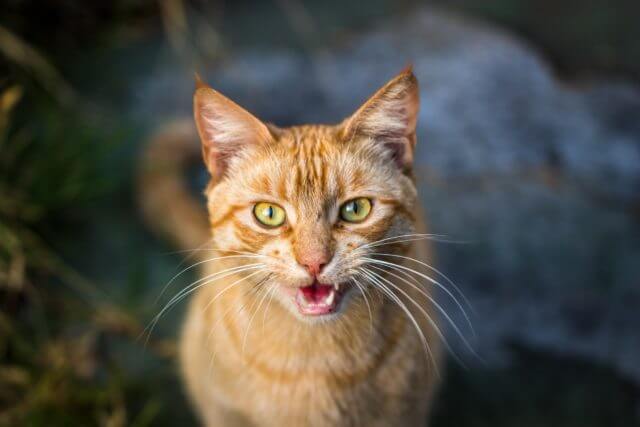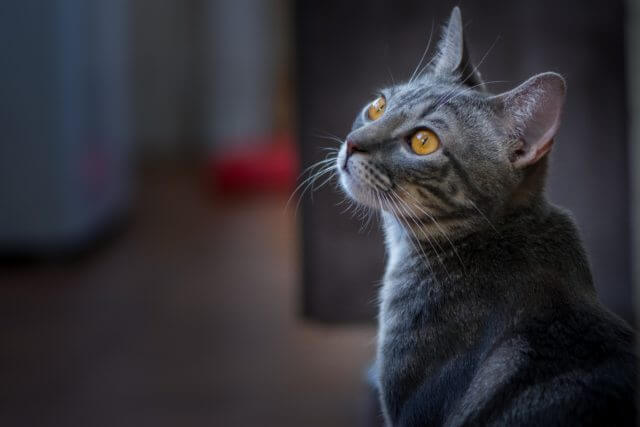People that live with cats can easily understand certain things that they are trying to tell us. Without words, cats can still convey their meaning to anyone who is tuned into the “feline-ese”.
Are you aware of all the ways your cat communicates with you? Here are a few of the “words” she uses to tell you what she needs and feels.
1. Meowing
I think we can all agree that meowing is a form of communication. Animal experts say that meows are an attempt to convey a need, physical, emotional, or social. People seem to think that cats speak to each other through meows, but actually, adult felines rarely communicate with other cats in this way. However, everyone who lives with a cat knows that their cat’s meow carries meaning in their own interaction.
It seems to be somewhat of a secret, personal language between a cat and their person/people. No one knows if this is because the owner has adapted to what the cat is trying to communicate or if the cat has adapted to what the owner seems to respond to.
2. Yowling
Yowls are vocalizations that are prolonged and intense. They usually indicate a more pressing need, like a mating call, frustration, or a fear scream. The people that are closest to the cat are the most likely to know the meaning of each individual cry for their cat.
One should take into account all the factors when trying to interpret a yowl and prioritize safety above all. If your cat is not spayed or neutered, his yowl could be sexual. If there is another cat outside that your cat sees and she yowls, it could be aggressive or territorial as well. If your cat is backed into a corner and showing other signs of fear, like a raised back or puffed hair, the yowl could be a fear response. Because yowls usually indicate arousal or aggression, it is best to avoid provoking a yowling cat and instead, try to figure out the meaning from a distance.

3. Rubbing
Cats have glands on the sides of their faces that produce chemical messages. The facial pheromones can indicate comfort and safety. If your cat rubs you (or items in your home) with his face, he wants to mark you as “safe”. Wild felines that live in family groups can be seen rubbing familiarly with other family members and this is called allogrooming. It can be interpreted as a sign of familiarity, trust, and safety. Be flattered that your cat rubs on you. He is telling you he feels safe.
4. Purring
Most cats purr in contentment. Occasionally, a fearful cat will purr, but when your cat is comfortable with you and appears otherwise relaxed, her purr is usually a sign of calm contentment. I love to hear a cat purr. It makes me feel happy. A study several years ago done on rabbits suggested that the vibration of purring falls within a range that best promotes fracture healing, so some even say that purring is therapeutic. A purring cat is expressing pleasure and serenity.

5. Pupils and Blinking
If you observe your cat’s eyes, you can truly see windows to her soul. Her pupils will dilate in response to fear, and even the way she blinks can tell you about her emotional state. When cats are relaxed, they will blink slowly. When they are aroused and intense, they may not blink at all and will stare, wide-eyed. If your cat slowly blinks when he sees you, he is comfortable and happy.
If you feel that your cat is ill at ease or communicating something different to you, contact your veterinarian to make sure nothing is wrong. Cats are very good at hiding disease and sometimes the signs will be subtle. All cats (even ones that seem healthy) need to have a full veterinary exam at least once yearly.
All of these cues can be communicated to you as a cat lover. You probably instinctively know what your cat is telling you already, but may not have thought of the specific details. Now you can look at your cat and see the signals that confirm what you already know in your heart – your cat loves you!
Do you love cats and learning about them? I love sharing about all animals! Follow me on Facebook by clicking here.
- Chen LP, Han ZB, Yang XZ.[The effects of frequency of mechanical vibration on experimental fracture healing]. Zhonghua Wai Ke Za Zhi. 1994 Apr;32(4):217-9. Chinese. PubMed PMID: 7842923.


